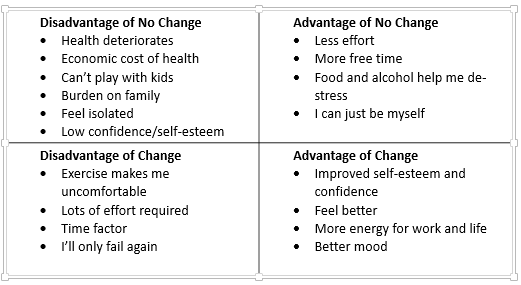Calculate Your Risk

Use this decisional balance sheet to steer clear of fear and inaction.
If only …
I would have made that investment before the stock split.
I would have started that business.
I wouldn’t have let him/her get away.
I would have taken better care of myself.
I would have known!
“If only,” the heaviest phrase in the English language—each of us at one time or another has felt suffocated under its weight. Why do we let ourselves get weighed down by regret? Why don’t we just do the things we know we should do? That might be one of the most significant, albeit frustrating, questions in human history! One that has gone largely unanswered.
Yet even if there was a definitive answer, would it matter? Would you or I do what we know we should do simply because we possess the knowledge that it’s good for us? If that were the case, no one would ever start smoking, or indulge in destructive dietary habits, or waste time frivolously instead of spending it wisely and so on. Knowledge does not always seem to be power.
One thing is certain: The reason our behaviors often seem to contradict our intentions is in no small degree related to the fact that everything we do, or at least wish to do, has a reward as well as risk. If reward is like a behavioral accelerator, driving us toward what we want, and risk is like the braking mechanism, stopping us from moving forward into danger, then we might be trying to reach our goal by pressing one foot on the gas and one on the brake. And often, we’re not prepared for the consequences (including going nowhere).
We associate change with loss
Daniel Kahneman and Amos Tversky won the Noble Prize for their work on loss aversion. What they found is that many of our decisions are motivated by the need to avoid loss, even at the expense of gain. Therefore, the ability to reconcile risk versus reward is an essential prerequisite to our achieving any goal we set for ourselves.
Drs. William Miller and Stephen Rollnick, pioneers of motivational interviewing, have used a tool known as the decisional balance sheet to weigh risk versus reward. An example of a decisional balance sheet focused on the benefits and drawbacks of starting an exercise program is pictured below.

A decisional balance sheet explores the advantages and disadvantages of either outcome. The objective of a decisional balance sheet is to create discrepancies and challenge our assumptions regarding the results of both making the changes we desire and not changing.
Just because we make the decision to change, it doesn’t automatically mean we will change. When we decide to do something, like start on an exercise program, for example, one of two outcomes will occur: We will either change or not change.
Creating a decisional balance sheet can help you take the steps toward achieving a goal that’s important to you. Choose an area of your life in which you have thought about making changes, and then follow the steps below.
Step 1: Draw your decisional balance sheet
Draw a decisional balance sheet like the one above. Fill it out completely. Be as explicit as possible. Avoid rationalizing about whether or not your assumptions are correct, rational, etc. This is about what you truly feel, not what you believe you should think and feel.
Step 2: Assess the disadvantages of change
Once you have your decisional balance sheet completed, look at the box in the lower left corner that indicates the disadvantages of change. This box contains your fears and apprehensions. Very often, because of our past conditioning and the meaning we attach to our disappointments in a certain area of life, we develop automatic negative thoughts that are evoked any time we think about taking action in that realm. This is the little voice inside your head that instills fear and doubt.
If right now you’re thinking, “What? That’s crazy. I don’t have a little voice in my head. I don’t know what this guy is …” That’s the voice! You’ll likely recognize some of the automatic negative thoughts listed in the chart above. It’s important to understand that this voice isn’t right; it’s merely afraid and therefore apprehensive. Take a look at all the disadvantages of change you have written in this box. Which one is the most disturbing to you? Challenge it! Ask yourself, “Where is the evidence for this? How can I be absolutely sure that will occur as a result of changing?” Another question to ask is, “What if that doesn’t happen? What if I have all this fear about this one thing holding me back and it never occurs?”
Step 3: Analyze the advantages of no change
Go to the box in the upper right corner. This box indicates the advantages of not changing. You want to not only challenge the responses you gave but also come up with some alternative answers. In the case of the chart above, how can the advantages of exercise outweigh the advantages of not exercising? Take the response “I will have more free time,” for example. Flip that response and ask yourself, “If I’m not in shape, in what way(s) could that level of conditioning and energy limit the choices I have regarding how I spend my free time?” Asking the following question can introduce another perspective: “If I had the energy, vitality and confidence I desire, what would I be able to do in my free time that I currently can’t or won’t?”
Step 4: Gauge the disadvantages of no change
In the upper left corner, examine the disadvantages of not changing. Which one of those disadvantages would affect you the most? For example, for an answer like “can’t play with the kids” in the chart above, think about what experiences that could cost you. What memories or magical moments could you be creating with your kids that you’re not? In what ways could that limit your relationship with them? How could this situation get worse in the next year or in five or 10 years? Often when we see that it’s more painful to persist with a current behavior pattern than it is to replace it with a new one, it minimizes our reluctance to move forward toward the attainment of our goals.
Step 5: Find the biggest advantage
Look at everything you wrote in the lower right corner in the box for the advantages of change. Which one of these is the single most important to you? What is the impact of experiencing that one thing? What will you have in your life as a result of that one advantage? What will that feel like? In what ways will your life be positively affected by that one advantage in a year or in five or 10 years from now?
Finally, what is one step you can take toward the attainment of that one outcome? What does progress look like? Be as specific as possible. Then write down what success looks like. The attainment of the biggest goals we set for the future depends on our willingness to take even the smallest step in the present.
Photo credit: leonardo2011 AdobeStock 961136